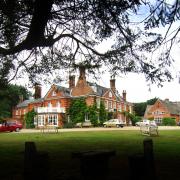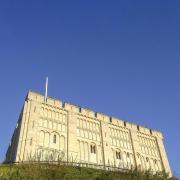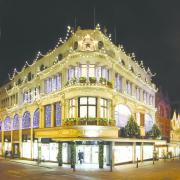White-sailed, black-towered, boat-capped windmills punctuate the wide marshes and big breezy skies of the Broads. Now more sails are turning and more towers are still standing, thanks to an imaginative five-year restoration project
All four sails of Mutton’s Mill are turning once again, each majestic revolution out on Halvergate marshes a testament to a restoration project which has swept across the isolated waterways and grazing meadows.
The picturesque mills which pepper the wide landscapes and skyscapes of the Broads are not just the focus of a thousand paintings and photographs. They helped create this water-infused scenery.
Four centuries ago, flooding threatened the marshy land. The solution was to use wind power to pump water out to sea.

The windmills of the Norfolk and Suffolk Broads are actually wind pumps. Instead of using the wind to mill corn, they used it to lift water into the rivers. Early windmills used fabric sails, hence the name for the huge arms which turn with the wind.
Today the wind pumps of the Norfolk and Suffolk Broads are the largest concentration of wind pumps in the country – and second only to the Netherlands in the world.
More than 60 still stand proud across the Broads, typically brick towers, with wooden caps like upturned boats which were originally made by local boat-builders.
The oldest surviving Broads wind pump, at Oby, dates back to 1753, with the last wind pump still draining the marshes until 1953, when a gale ripped the sails from Ashtree Farm Mill north of Breydon Water.

Through the centuries the technology was refined. At first wind turned sails which lifted huge scoops of water, then it drove turbines; eventually steam, diesel and electric power took over. Today computer-controlled electric pumps and sluices keep flooding at bay.
For the past five years the Water, Mills and Marshes project, run by the Broads Authority and funded by the Heritage Lottery Fund, has focused on restoring, conserving and interpreting this unique landscape.
In the wild Halvergate marshes between the rivers Bure and Yare and Breydon Water, wind pumps have been repaired and restored, and landscapes opened up to local people and visitors through a new information and walking trail.
Towers have been patched and plastered, crumbling internal machinery repaired, rotten doors, hatches and windows reinstated, lost caps, fans and sails replaced.

And as the work was carried out, disappearing heritage skills were passed to a new generation. Students at City College Norwich learned how to work on historic buildings using lime mortar, linseed oil and the intricate carpentry and brickwork techniques honed over hundreds of years.
Kate Knights, historic environment manager for the Broads Authority, said there is a national shortage of millwrights – experts in the restoration of historic mills. The authority was able to take on two apprentices as part of the project, and introduce City College construction students to the joy and challenge of working on historic buildings.
Tom Allen was one of those students. He became a Broads Authority apprentice and is now site supervisor for the Water, Mills and Marshes project.
‘I came out for a day’s work experience!’ said Tom.

Enthralled by what he saw he added bricklaying skills to his carpentry and has been able to complete specialist repairs to the tapering circular walls of Norfolk’s historic mills, as well as helping to restore the complex wooden structures which have transformed wind into pumping-power over the centuries and are still an intrinsic part of this internationally-important landscape.
At North Mill, east of Reedham, the old tower was open to the elements, with great holes in the brickwork, exacerbated by cattle. It has been meticulously repaired – emerging from a cage of scaffolding to tower over the marshes once more.
At nearby High’s Mill floors and ladders have been reinstated inside, brickwork and external machinery restored and protected outside and the top re-capped with its upturned-boat roof.
Four-storey Six Mile House Mill, at Runham, near Thrigby, had been open to the elements with vegetation growing from the walls. It too is now restored to stand proud against the skyline, as is Strumpshaw Engine House on the RSPB Strumpshaw reserve.

At Mutton’s Mill, near Halvergate village, the work included repairs to the brick tower, to the wooden cap and fantail at the top and to the machinery inside.
Tom helped a millwright create restore the huge sails – repairing the two remaining sails and constructing two entirely new copies, partly in the workshops at City College and partly out on the site, which is only accessible by track.
The mill was built almost two centuries ago and has the only surviving internal scoop wheel on the Broads. It drained water from the marshes into Halvergate Fleet until 1946 and is owned by two friends who bought and restored it 50 years ago. They worked alongside the Heritage Lottery Fund-funded team on this latest restoration.
This summer all four sails were installed and are once again turning in the wind.

‘It looks so good now,’ said Tom. ‘It really stands out with its white cap and sails and black tower. I didn’t know anything about mills when I first came out here. Now I would love to stay in heritage work and work on more mills. When I started the carpentry course it never occurred to me that I would get a job working on windmills.’
Initial plans were to get Mutton’s Mill pumping water again too, but although the machinery is in place it became clear that getting, and keeping, it working would have been too labour-intensive.
‘When the mills were draining the marshes it would have been a very different landscape. It would have looked quite industrial with all the mills turning and people living out there to keep all of them working,’ said Kate.
Today many of these remnants of an industrial past, and intrinsic part of a treasured landscape, still belong to private individuals. Others are owned or looked after by charities and trusts including the Norfolk Windmills Trust, English Heritage and the National Trust; these are the most likely to be open to the public.

Imposing Horsey Mill, on the east coast between Martham and Sea Palling, is owned by the National Trust and open regularly. The splendid sails turning at Hardley Mill on the river Yare, near Loddon, are driving machinery which can still pump water. It has its own group of friends and opens regularly.
Thurne Mill, linked to the Wind Energy Museum at Repps with Bastwick, also has regular open days.
Nearby is Bond Island Windmill, once owned by Roger Moore and now a James Bond themed holiday house.
Berney Arms Mill, owned by English Heritage and currently closed for repairs, is one of the biggest mills on the Broads. Unusually, it was built to grind kiln-fired chalk and clay for cement. Converted into a wind pump in 1883, it drained water from the marshes until 1948. Close to Mutton’s Mill, on the A47 Acle Straight, is imposing Stracey Arms mill, looked after by the Norfolk Windmills Trust, and also newly-restored, with sails turning in the wind.

Across the Halvergate Marshes Conservation Area there are 28 listed buildings and the whole area is on Historic England’s Heritage at Risk Register - but with crumbling towers painstakingly repaired and restored sails turning majestically in the wind, the outlook is brighter.
Of all the mills in the Broads, Kate loves Mutton’s Mill best right now.
It is the most recently restored, its sails sweeping across the marshes, two carefully repaired, two newly created, topping off the restoration of tower, machinery and roof as part of a five-year collaboration of heritage experts, Norfolk students and lottery money.
‘When you are out there you are pretty close to the A47 but you feel like you are in the middle of nowhere,’ said Kate.

From the top of the tower, windswept marshes unfurl for miles. It is a view the windmills were built for, centuries ago. Now they are saved, alongside the skills to look after them, for future generations – a vital part of a precious landscape that is both wonderfully wild and ingeniously constructed.
See Mutton’s Mill, Berney Arms Mill, High’s Mill and Howard’s Mill, as part of the Halvergate Mills Trail - another part of the Water, Mills and Marshes project.
The seven-mile walk with views across many of the mills of Halvergate marshes, can be started from Berney Arms railway halt or Stone’s Road car park, Halvergate.
The Water, Mills and Marshes project in Britain’s biggest protected wetland aims to preserve and promote the Broads. It brings together 55 organisations to increase information about the Broads, encourage people out into the landscape, protect and enhance threatened historic places, create and connect habitat corridors, improve land and water management, and encourage community projects.
watermillsandmarshes.org.uk




























